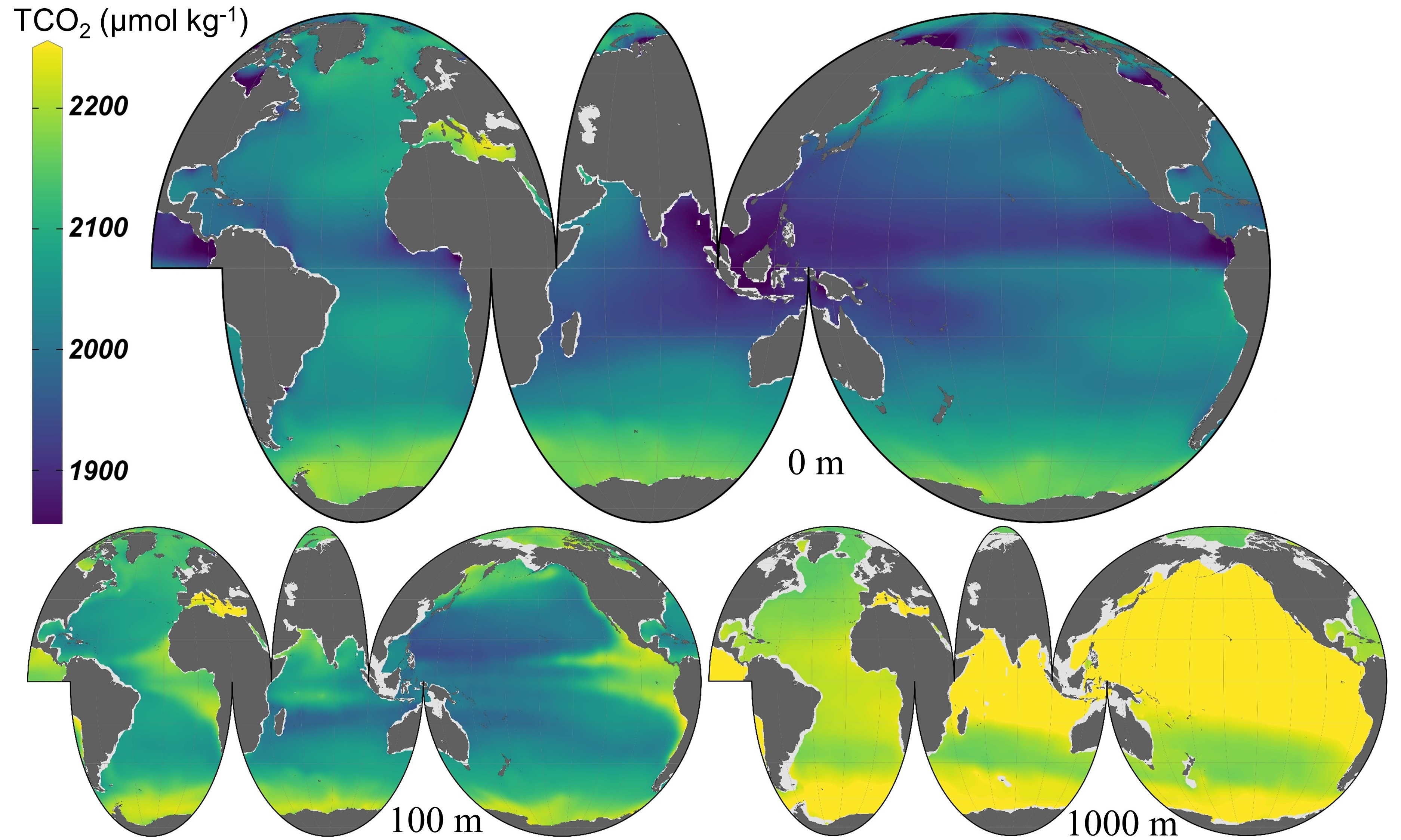NDP-105 (2020)
NCEI Accession 0222469, NDP-105 Data and Documentation Files
A global monthly climatology of oceanic total dissolved inorganic carbon (DIC): a neural network approach (NCEI Accession 0222469)
Daniel Broullón1, Fiz F. Pérez1; Antón Velo1; Mario Hoppema2; Are Olsen3; Taro Takahashi4; Robert M. Key5; Toste Tanhua6; J. Magdalena Santana-Casiano7; Alex Kozyr8
Prepared by Alex Kozyr8
1Instituto de Investigaciones Marinas, CSIC, Eduardo Cabello 6, Vigo, 36208, Spain
2Alfred Wegener Institute Helmholtz Centre for Polar and Marine Research, Postfach 120161, Bremerhaven, 27515, Germany
3Bjerknes Centre for Climate Research, Allgaten 70, Bergen, NO-5007, Norway
4Lamont-Doherty Earth Observatory (LDEO), 61 Route 9W, Palisades, NY, 10964, USA
5Princeton University; Department of Geosciences; Program in Atmospheric and Ocean Sciences (AOS), Sayre Hall, Princeton, NJ, 08544, USA.
6GEOMAR Helmholtz Centre for Ocean Research Kiel (GEOMAR), Marine Biogeochemistry, Kiel, 24105, Germany.
7Instituto de Oceanografía y Cambio Global, IOCAG, Universidad de Las Palmas de Gran Canaria, Las Palmas, Gran Canaria, Spain.
8National Centers for Environmental Information (NCEI), National Oceanic and Atmospheric Administration (NOAA), Silver Spring, MD, USA.

Abstract
Dissolved inorganic carbon (DIC) monthly climatology was created from a neural network approach (Broullón et al., 2020). The neural network was trained with GLODAPv2.2019 (Olsen et al., 2019) and LDEOv2016 (Takahashi et al., 2017) data, using as predictor variables position (latitude, longitude and depth), year, temperature, salinity, phosphate, nitrate, silicate and dissolved oxygen. pCO2 from LDEOv2016 and AT from Broullón et al. (2019) were used to compute DIC surface values to increase the surface coverage in the training data. The relations extracted between the predictor variables and DIC were used to obtain the climatology passing through the network global monthly climatologies of the predictor variables: temperature and salinity fields of the World Ocean Atlas version 2013 (WOA13), filtered WOA13 oxygen (fifth-order one-dimensional median filter through the depth dimension; see Broullón et al., 2019 for details) and nutrients computed using CANYON-B (Bittig et al., 2018) over the three previous fields. The obtained climatology has a 1ºx1º spatial resolution and 102 depth levels between 0 and 5500 m, with a monthly resolution from 0 to 1500 m and an annual resolution from 1550 to 5500m.
Please cite this data set as:
Broullón, Daniel; Pérez, Fiz F.; Velo, Anton; Hoppema, Mario; Olsen, Are; Takahashi, Taro; Key, Robert M.; Tanhua, Toste; Santana-Casiano, J. Magdalena; Kozyr, Alex (2020). A global monthly climatology of oceanic total dissolved inorganic carbon (DIC): a neural network approach (NCEI Accession 0222469). NOAA National Centers for Environmental Information, https://doi.org/10.25921/ndgj-jp24.
Please cite the mapping method as:
Broullón, D., Pérez, F. F., Velo, A., Hoppema, M., Olsen, A., Takahashi, T., Key, R. M., Tanhua, T., Santana-Casiano, J. M., and Kozyr, A.: A global monthly climatology of oceanic total dissolved inorganic carbon: a neural network approach, Earth Syst. Sci. Data, 12, 1725–1743, https://doi.org/10.5194/essd-12-1725-2020, 2020.
Dataset description:
The netcdf file contains: -latitude: latitude in degrees north (-77.5:89.5 with 1º resolution) -longitude: longitude in degrees east (-179.5:179.5 with 1º resolution) -depth: depth in meters (0 – 5500m with 102 depth levels of WOA13) -TCO2_NNGv2LDEO: TCO2 in µmol kg-1 (dimensions: longitude, latitude, depth, time)
References
Bittig, H. C., Steinhoff, T., Claustre, H., Fiedler, B., Williams, N. L., Sauzède, R., Körtzinger, A., and Gattuso, J.-P.: An alternative to static climatologies: robust estimation of open ocean CO2 variables and nutrient concentrations from T, S, and O2 data using Bayesian neural networks, Front. Mar. Sci., 5, 328, https://doi.org/10.3389/fmars.2018.00328, 2018.Broullón, D., Pérez, F. F., Velo, A., Hoppema, M., Olsen, A., Takahashi, T., Key, R. M., Tanhua, T., González-Dávila, M., Jeansson, E., Kozyr, A., and van Heuven, S. M. A. C.: A global monthly climatology of total alkalinity: a neural network approach, Earth Syst. Sci. Data, 11, 1109–1127, https://doi.org/10.5194/essd-11-1109-2019, 2019.
Broullón, D., Pérez, F. F., Velo, A., Hoppema, M., Olsen, A., Takahashi, T., Key, R. M., Tanhua, T., Santana-Casiano, J. M., and Kozyr, A.: A global monthly climatology of oceanic total dissolved inorganic carbon: a neural network approach, Earth Syst. Sci. Data, 12, 1725–1743, https://doi.org/10.5194/essd-12-1725-2020, 2020.
Olsen, A., Lange, N., Key, R. M., Tanhua, T., Álvarez, M., Becker, S., Bittig, H. C., Carter, B. R., Cotrim da Cunha, L., Feely, R. A., van Heuven, S., Hoppema, M., Ishii, M., Jeansson, E., Jones, S. D., Jutterström, S., Karlsen, M. K., Kozyr, A., Lauvset, S. K., Lo Monaco, C., Murata, A., Pérez, F. F., Pfeil, B., Schirnick, C., Steinfeldt, R., Suzuki, T., Telszewski, M., Tilbrook, B., Velo, A., and Wanninkhof, R.: GLODAPv2.2019 – an update of GLODAPv2, Earth Syst. Sci. Data, 11, 1437–1461, https://doi.org/10.5194/essd-11-1437-2019, 2019.
Takahashi, T., Sutherland, S. C., and Kozyr, A.: Global Ocean Surface Water Partial Pressure of CO2 Database: Measurements Performed During 1957–2016 (Version 2016), ORNL/CDIAC-161, NDP-088(V2015), Carbon Dioxide Information Analysis Center, Oak Ridge National Laboratory, US Department of Energy, Oak Ridge, Tennessee, Dataset, Document available at: https://www.nodc.noaa.gov/ocads/oceans/LDEO_Underway_Database/NDP-088_V2016.pdf
